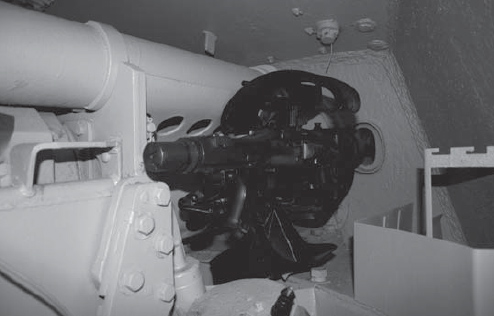
To resist penetration, tank armor needed to be hard to deflect or shatter an incoming round, but also flexible to diffuse its impact energy and retain structural integrity. Like other heavy, late-war armored vehicles the Tiger II relied on thickness to counter most antitank projectiles of the period. Its hull and turret comprised rolled homogeneous armor (RHA) made from cast ingots infused with chromium and molybdenum to increase deep internal hardening and stress resistance. By compacting and consolidating the metal’s microscopic grains to a consistent size and orientation, the plate was strengthened and better able to defeat an incoming round. Homogeneous armor worked best when it was the same hardness throughout, as variations promoted stress concentration boundaries and weakened its ballistic resistance. With the vehicle’s glacis and mantlet 150mm and 180mm thick respectively, achieving such consistency was not easy.
As the production process was consistently hampered by Allied bombing, the tempering process of heating the raw metal to 800°C, cooling it in water, re-heating it at a lower temperature, and cooling it again could not always be done to the accuracy required to produce the desired ductility of alloyed steel armor plate. As a result of this “scale effect” a crystalline microstructure (collectively called bainite) could form internally, which increased hardness and the potential for cracking on impact. Subsequently, an impacting projectile’s shockwave would be likely to produce an internal showering of sharp metal flakes known as spall. The Germans tended to use the Brinell scale to determine armor’s hardness, which on the Tiger II’s glacis and hull sides were BHN 220–265 (150mm) and 275–340 (80mm), respectively. With late-war stockpiles of molybdenum, nickel, and manganese dwindling as the war progressed, vanadium was used as a grain-growth inhibitor to improve the RHA’s toughness.

A Tiger II’s turret-mounted coaxial MG 34 Panzerlauf, the standard German Army 7.92mm recoil-operated machine gun. To internalize the weapon its barrel was covered with an armored housing and the butt stock was removed. Below is the alternate turret traverse wheel. (Author’s collection)
As a smaller profile reduced the chance of being hit, the Tiger II’s turret, probably the most exposed part during combat, was tapered in the front, and backed up with 180mm of face armor and a dense, curved “Saukopf” mantlet. This meant that when the barrel was pointed at an adversary the turret would either defeat front-on shots owing to that area’s great thickness or deflect those striking the sides owing to the great angle. A second benefit of using hard, thick armor was that high-speed incoming rounds often fell into a “shatter gap” where they simply disintegrated on striking the vehicle. Sloped armor also increased the plate’s effective thickness. Combined, these aspects translated into the vehicle’s frontal armor being essentially impenetrable to existing Allied guns, while side plate armor proved adequate when fighting at the commonly long ranges afforded by the main gun.


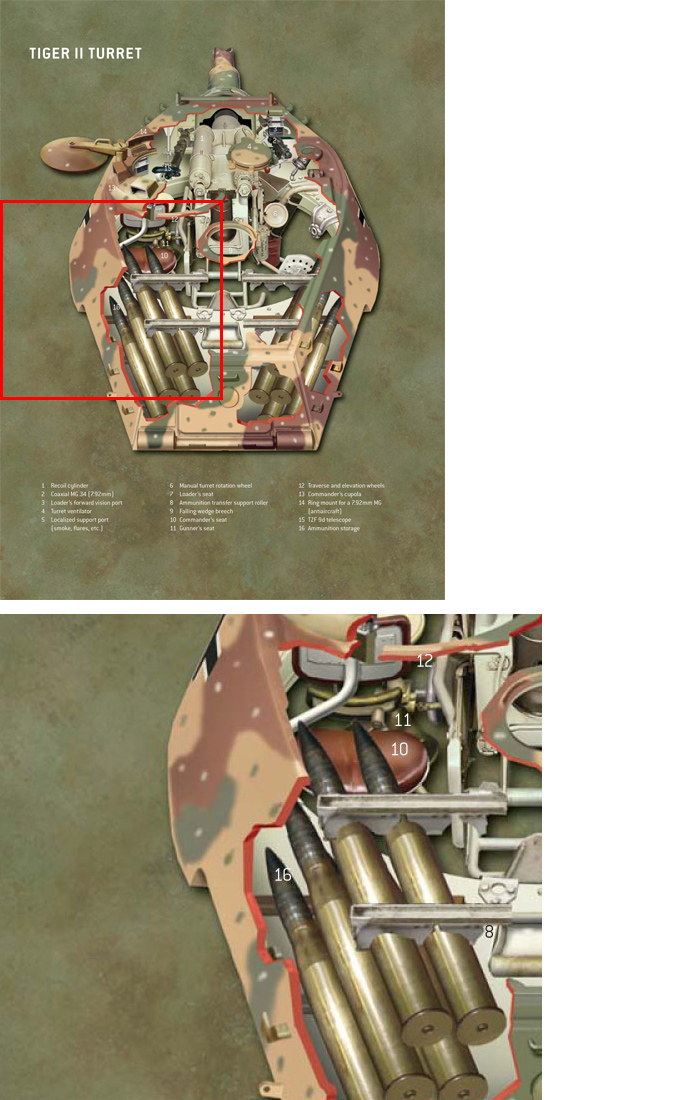



The Pzgr Patr 39/43 (1), an APCBC/HE-T round, was the Tiger II’s primary antitank round. Specifically designed to handle the high internal barrel pressures within the KwK 43 L/71 gun, the projectile possessed a tracer and a second driving band for added stability and accuracy over its PzGr 39-1 predecessor (which could still be used provided the main gun had fired fewer than 500 times). Its hard shell was capped by softer metal to minimize disintegration from high-velocity strikes, while the addition of a ballistic cap reduced drag. It also caused armor to crack and weaken before the shell made contact, and promoted better penetration, after which the shell’s Amatol (60 percent TNT/40 percent ammonium nitrate) bursting charge would explode. The projectile could also be used by other 88mm guns as indicated by the text on the cartridge, which also gives the weight (“6,900kg”); the explosive charge (“GuRP-G1,5-(725/650-5,1/2”), the manufacturer and manufacture date of the fuze (“dbg1943/1,” where “dbg” indicates Dynamit AG); and the manufacturing location and date of the round (“Jg20.1.43K”).
The Sprgr Patr 43 (2), an HE round, was used against unarmored vehicles, infantry, and static defensive positions. The projectile had no tracer, and except for a second driving band it was the same as the older L/4.7 version. It relied on Amatol explosive; as per the Pzgr Patr 39/43; and the projectile could also be used by other 88mm guns as shown by the text on the cartridge. The text on the shell indicates where and when the fuze was manufactured (“14 Jg20.1.43”); the round’s weight class (“III”); explosive (“R8”); and the round’s manufacturing location and date (“Jg18.1.43N”). The tip (firing pin and nose) and the piece extending into the round were the AZ 23/28 (Aufschlagzünder or "impact fuze"), around which was the main explosive filling. This fuze type could be set for direct-action or delay; it was so sensitive that tank crews were warned against firing through trees or other obstructions just beyond the barrel for fear of premature detonation.
The Gr Patr 39/43 Hl (3) was a HEAT (high-explosive antitank) that relied on a shaped-charge to penetrate armored vehicles. Again, the projectile could also be used by other 88mm guns as indicated by the text on the cartridge. The text on the shell indicates the kind of round (“Hl”); cyclonite/wax explosive (“91”); the fuze manufacturer and date (“Jg20.1.43”); the weight class (“III”), and the round manufacturer and date (“Jg18.1.43N”). The round’s tip comprised a small direct-action AZ 38 fuze, which on impact detonated a conventional hollow charge that was set back to allow the conical liner and explosive to properly form a high-velocity metal jet. The rear component is the detonator. As only about 7,000 shaped-charge Gr Patr 39/43 Hl rounds were produced their use was uncommon, and the round’s low velocity and degraded effectiveness from having to spin made it suspect with many crews.
The Pzgr Patr 40/43 (4), an HVAP/-T round, was to be used against the thickest enemy armor. The limited availability of tungsten after 1943 meant that the “HK” (Hartkernor “hard core”) Pzgr 40/43 armor-piercing composite rigid projectile was also produced with steel (“S” for Stahlkern) or iron (“W” for Weicheisen) core expedients. The all-black APCR (AKA high-velocity armor-piercing) acted as a kinetic penetrator and had a smaller explosive charge than the Pzgr Patr 39/43. Because of its lighter weight the shell was affected by wind resistance and decreased accuracy. Compared to the production of 1.98 million Pzgr Patr 39/43s and 2.48 million Sprgr Patr 43s, only about 5,800 Pzgr Patr 40/43s were made.
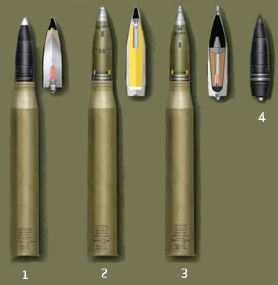
For the Tiger II Krupp and Rheinmetall-Borsig produced two prototypes of the new 88mm KwK 43 L/71 gun, with the former being an entirely new design and the latter simply a re-worked FlaK 41 L/74. As Krupp’s version was shorter, possessed a muzzle brake, and used shorter, more easily stored projectiles it was deemed superior and accepted for production. As an internally mounted variation of the PaK 43 antitank gun it was initially developed with a monoblock barrel and mated to Porsche’s “pre-production” turret. Considerable stress from firing high-velocity rounds, however, necessitated a change to a two-piece weapon, which eased construction and the ability to change barrels. A falling wedge breech block ejected spent shell casings and remained open for another round, and because of the main gun’s large size, a muzzle brake was installed both to vent unwanted propellant gases and to reduce recoil.
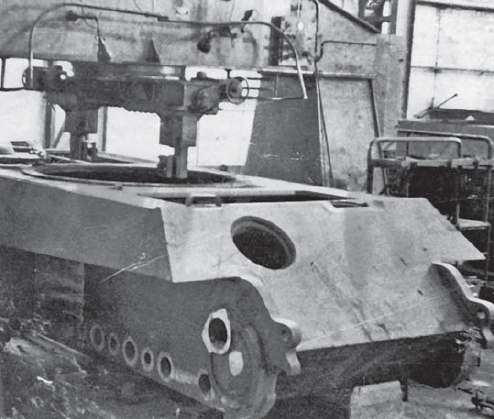
A Tiger II hull during the manufacturing process. As part of the “Takt 4” process a vertical lathe is being used to machine the opening for the turret. Concurrently, the hull sides would have been prepared for final drive casings. (DML)
To avoid production delays and to maximize vehicle hardware interchangeability, it was decided to use the HL (Hochleistungsmotor) 230 P (Panzermotor) 30 engine. Built by Maybach, Auto Union (four automobile manufacturers, including Audi), and Daimler-Benz it was being used in other heavy German armored vehicles including the medium 45-tonne Panther and late-model Tiger I. Because of the Tiger II’s additional weight a transverse torsion-bar suspension system comprising nine load-carrying axles per side was incorporated. This provided independent wheel movement in the vertical, increased stiffness in turns, helped retain stability over rough terrain, and allowed a theoretical maximum speed of 41.5kph over hard, level surfaces, although a much lower pace was recommended during general operation. As opposed to the Tiger I’s interleaved road wheels, its successor incorporated a twin steel-rimmed, rubber-cushioned type, which improved maintenance and cold-weather operation as ice and snow were less likely to impede rotation. Changing gears was surprisingly easy for a front driving sprocket that provided power to the “shoe” and “connector link” style continuous tracks, which were tensioned by a rear idler, and controlled via power steering.
This table presents the penetration (in mm) of rolled homogeneous armor at 0 degrees and 30 degrees (separated by a forward slash in each case). Although these figures are derived from period Allied and German testing documentation, they cannot be considered completely accurate due to deviations in plate manufacturing and composition, penetration criteria, and ammunition quality.
| 100m | 500m | 1,000m | 1,500m | 2,000m | |
| Pzgr 39/43 (APCBC-HE-T) | 233/202 | 219/185 | 204/165 | 190/148 | 176/132 |
| 10.4kg (warhead), 23.35kg (total); 1,018m/sec | |||||
| Pzgr 40/43 (HVAP/-T) | 274/237 | 251/217 | 223/193 | 211/170 | 184/152 |
| 7.3kg (warhead); 1,130m/sec | |||||
| Gr Patr 39/43 Hl (HEAT) | 90/90 | 90/90 | n/a | n/a | n/a |
| 7.65kg (warhead), 16kg (total); 600m/sec | |||||
Internally, crew communication was conducted through the Bordsprechanlage B Intercom. As the standard intercom box installed on vehicles from the Panzer III to the Tiger II, it comprised an audio frequency amplifier for volume control. An FuG 5 ultra-short-wave 10-watt transmitter/USW receiver (Wireless Telegraphy and Radio Telephony) was used for external communication to a range of 6km and 4km, respectively. The associated 2m hollow sheet-steel rod antenna was mounted on a rubber base for additional flexibility when traveling through heavy foliage or under low obstructions such as bridges.

A view of the Tiger II’s driver’s position showing the two-spoke LSt02 steering device, emergency lateral control lever (to its right), radio racks, and gearbox. To the far right hull ammunition storage is visible. (Author’s collection)
This table presents the penetration (in mm) of rolled homogeneous armor at 0 degrees and 30 degrees (separated by a forward slash in each case). Although these figures are derived from period Allied and German testing documentation, they cannot be considered completely accurate due to deviations in plate manufacturing and composition, penetration criteria, and ammunition quality.
| 100m | 500m | 1,000m | 1,500m | 2,000m | |
| BR-471 (APHE-T) | Not known/137 | 152/122 | 142/115 | 133/107 | 118/96 |
| 24.97kg; 792m/sec | |||||
In an effort to increase production numbers and keep costs low by avoiding complex, expensive milling facilities the IS-2 incorporated cast armor as much as possible. In contrast to the extensive machining used to construct the German Tiger II, casting involved little more than producing a mold into which molten metal was poured and allowed to cool. The process gave the flexibility to make armor of various thicknesses and curves, and by virtue of the latter exposed less exterior surface area for the equivalent volume, but it also produced several inherent imperfections.
Externally, cavities (risers) needed to be incorporated into the mold to compensate for a metal’s quality of shrinking and becoming denser as it cooled, and the areas where the molten metal entered the cast (gate marks) needed to be removed once the armor had cooled. Unlike RHA the grain structure was not rolled or otherwise modified, and was therefore not as strong or resilient. Because of contemporary manufacturing technologies and techniques, Soviet cast armor suffered from inconsistent thicknesses across the same mold. To accommodate for such differences turret and hull tolerances were kept loose and minor fitting modifications were occasionally needed.
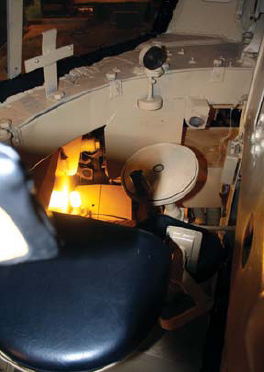
A view of the Tiger II’s commander and gunner positions next to the turret traverse wheel. The device mounted to the turret ring is an azimuth indicator displaying 1 to 12 o’clock. Note the metal attachment on the gunner’s seat for the commander’s foot to rest upon. (Author’s collection)

A Tiger II crewman inspects the front drive sprocket under the driver’s position. As no access panel or suspension component is in the area, debris probably needs to be removed. (DML)
Internal flaws due to improper heat treatment or the use of low-quality alloys were also common, which with the substitution of manganese for nickel resulted in a hard, high-carbon finished product, especially along the weld seams. Soviet armor plate averaged BNH 420, which on the IS-2 was an even more brittle BNH 450 and BNH 440 on the turret and hull respectively. In general cast armor was hard and resisted penetration better than steel, but it was also more prone to shattering. Although higher-quality Lend/Lease US steel was becoming more available, an attempt was made to harden the armor using tempering in order to better defeat uncapped armor-piercing rounds, but it was abandoned owing to increased production times and cost.
As the D-25T was essentially the M1931 A-19 field gun, the IS-2’s main gun initially incorporated the same interrupted screw-type breech block and a recoil system consisting of a hydraulic recoil buffer and hydropneumatic recuperator, both located inside the cradle under the barrel. While well suited for attacking infantry and defensive positions, the IS-2’s large bore fired a shell with considerable mass that could buckle or deform even the strongest enemy armor should penetration not result. Although the vehicle’s BR-471 antitank round traveled at just 77 percent of the Tiger II’s Pzgr 39/43, it produced 1.45 times more muzzle energy.
Unlike the Germans, with their variety of antiarmor projectile choices, the Soviets relied on just the armor-piercing, high-explosive (APHE) round, of which the IS-2 carried eight. Soviet armor-piercing projectiles improved after late 1943 as their steel increased in hardness from 460 BHN steel to 550, each increase of 10 BHN roughly equating to a 1 percent improvement in penetration. A more advanced BR-471B armor-piercing capped round (APHEBC) that was better able to penetrate sloped armor was ordered in the spring of 1945, but arrived too late to be issued for combat in Europe. The IS-2’s remaining 20 rounds were blast/fragmentation (HE) OF-471 or OF-471N rounds, which gives an idea of the kinds of targets the vehicle was most likely to encounter.
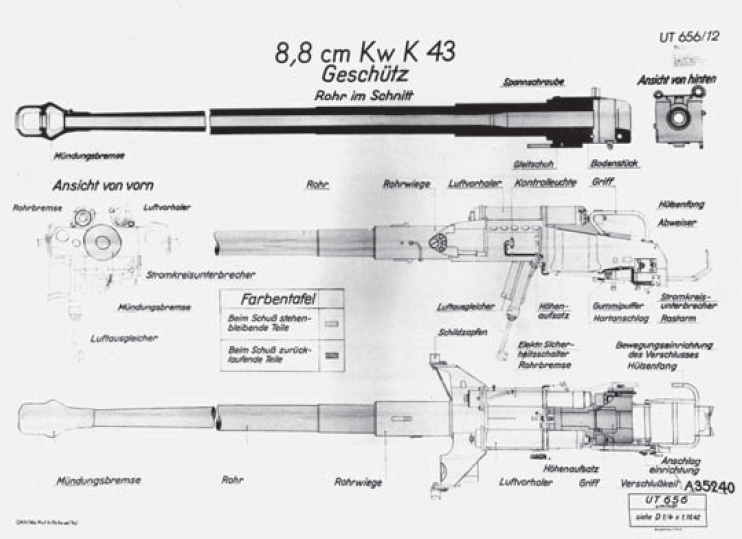
This cross-section diagram of the 88mm KwK 43 L/71 barrel shows the recoiling and recoil absorbing mechanisms as dark and light shaded areas, respectively. These include the Luftausgleicher (air balancer), Abweiser (deflector), Hülsenfang (case catch), and Verschlusskeil (catch wedge). (DML)
As developing a new engine for the IS series was not possible due to time constraints and cost, Kotin simply upgraded the one being used on the KV-1. To ensure that the vehicle started in very cold temperatures the IS-2 had a manual and electric capability, with a backup relying on compressed air. A high-pressure NK pump worked with an RNA governor to regulate fuel flow and engine speed as well as preheat the fighting compartment. A multistage air cleaner was also added as the loose tolerances on Soviet armored vehicles resulted in a considerable amount of debris in the oil. The mechanical, detachable transmission made for easier maintenance and used a multiple dry main clutch, mechanical gearbox with a reduction gear, and a planetary two-step traversing gear. Although the Christie suspension proved a successful design on the T-34 it did not function well with vehicles over 35 tonnes. As such the IS-2 incorporated a German-derived torsion bar system with all-steel wheels encompassed by lighter “Chelyabinsk tracks” that featured alternating flat links, and excellent traction.

A D-25T with its mantlet, breech block, and TsAKB style muzzle brake. (DML)
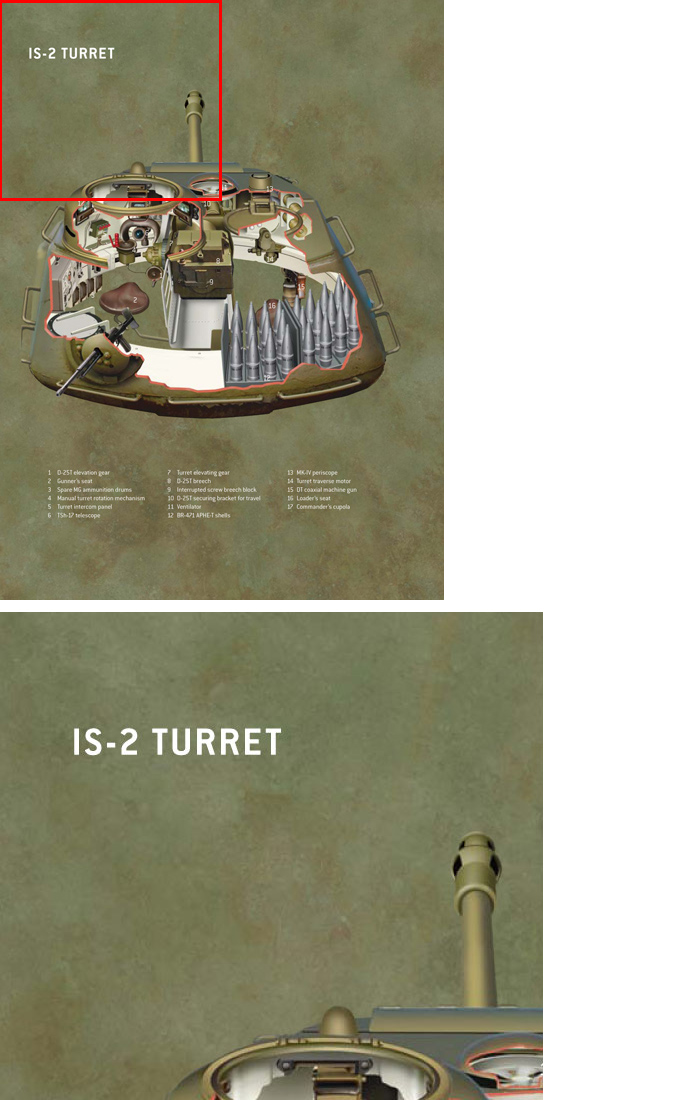





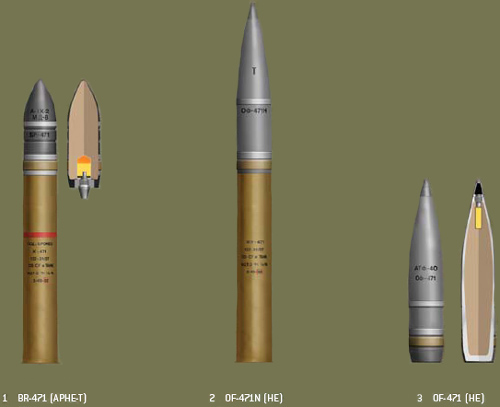
The armor-piercing 122mm BR-471 (“БΡ-471” in Cyrillic), a base-detonating (“МД-8”) APHE-T round (1), comprised an RDX-based explosive (“A-IX-2”) and tracer to assist in penetration and targeting visibility, respectively. The red band on the cartridge indicates that it should be paired with the BR-471. The shell’s deep grooves helped control its breakup during impact and maintain the explosive charge’s integrity until detonation. From top to bottom, the text on the cartridge reads: “ПОД БΡОНЕБ” (under armor), “Ж-471” (charge-471), “122-31/37” (referring to the 122mm A-19 field gun, which was also known as the M1931/37), “122-СУ И ТАНК” (for SU-122 assault gun or tank use), “НДТ-3 19/1 1/45N” (charge mark), and “2-45-02” (the date of production).
The OF-471N (“ОФ-471H”) short HE round (2) used Amatol (“АТФ-40”) (60 percent TNT/40 percent ammonium nitrate) as an explosive, while the OF-471 (“ОФ-471”) long HE round (3) used Trotyl (indicated by “T”) (70 percent tetryl/30 percent TNT); “ОФ” indicates fragmentation high explosive. Both of these semi-fixed rounds incorporated an RGM (point detonating) fuze and could be used against armored and static defensive targets alike. When used against armor the large-diameter round produced an effect resembling a squash head where the powerful explosive produced shock waves and spalling. Except for the text on the charge indicating a normalized (H) steel shell (“ЖН-471”) the text on the cartridge is identical to that shown on the Ж-471 used for the BR-471.

A 122mm OF-471 HE shell and the internal components of its cartridge. (DML)
For internal communication IS-2 crews used a TPU-4 telephone/intercom system incorporating headphones within a crash helmet and an uncomfortable, rugged throat microphone. Early vehicles were fitted with the same 10-R simplex (unidirectional) lamp heterodyne short-wave radio as had been used in the T-34/76 from the beginning of the war. It operated between 3.75 and 6MHz with a voice range of up to 24km when the vehicle was stationary (16km when moving), with non-vocal communication such as Morse code used as an alternative. As was common, the device comprised a separate transmitter and receiver, each with a rotary transformer, which were mounted on a rubber-bushed shock pad. Most IS-2s contained an improved, more easily produced 10-RK radio, which offered the same ranges, and allowed for the smooth selection of operating frequencies, often with an accompanying 4m umbrella antenna.